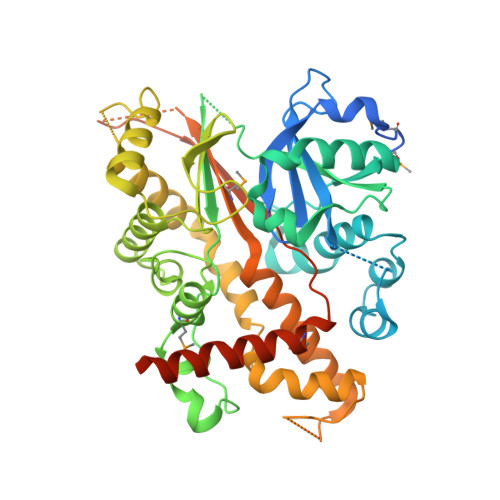Inositol phosphate-induced stabilization of inositol 1,3,4,5,6-pentakisphosphate 2-kinase and its role in substrate specificity.
Gosein, V., Leung, T.F., Krajden, O., Miller, G.J.(2012) Protein Sci 21: 737-742
- PubMed: 22362712
- DOI: https://doi.org/10.1002/pro.2049
- Primary Citation of Related Structures:
3UDS, 3UDT, 3UDZ - PubMed Abstract:
Inositol phosphate kinases (IPKs) sequentially phosphorylate inositol phosphates (IPs) on their inositol rings to yield an array of signaling molecules. IPKs must possess the ability to recognize their physiological substrates from among a pool of over 30 cellular IPs that differ in numbers and positions of phosphates. Crystal structures from IPK subfamilies have revealed structural determinants for IP discrimination, which vary considerably between IPKs. However, recent structures of inositol 1,3,4,5,6-pentakisphosphate 2-kinase (IPK1) did not reveal how IPK1 selectively recognizes its physiological substrate, IP5, while excluding others. Here, we report that limited proteolysis has revealed the presence of multiple conformational states in the IPK1 catalytic cycle, with notable protection from protease only in the presence of IP. Further, a 3.1-Å crystal structure of IPK1 bound to ADP in the absence of IP revealed decreased order in residues 110-140 within the N-lobe of the kinase compared with structures in which IP is bound. Using this solution and crystallographic data, we propose a model for recognition of IP substrate by IPK1 wherein phosphate groups at the 4-, 5-, and 6-positions are recognized initially by the C-lobe with subsequent interaction of the 1-position phosphate by Arg130 that stabilizes this residue and the N-lobe. This model explains how IPK1 can be highly specific for a single IP substrate by linking its interactions with substrate phosphate groups to the stabilization of the N- and C-lobes and kinase activation.
- Department of Pharmacology and Therapeutics, McGill University, Montreal, Canada, H3G 1Y6.
Organizational Affiliation:





















